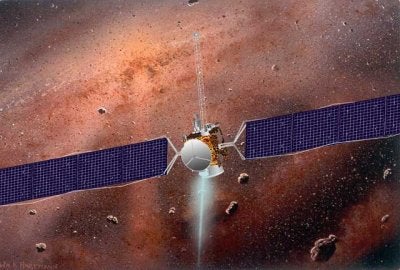As the Dawn spacecraft, which began its journey to the asteroid belt in 2007, nears Mars scientists at the Tucson-based Planetary Science Institute (PSI) prepare to use the February 18 encounter to tune up Dawn’s Gamma-Ray and Neutron Detector (GRaND) instrument.
Dawn’s instrument payload includes a visible-light camera, a visible-light and infrared mapping spectrometer, and GRaND.
The GRaND team will be involved in several activities during the February 18 Mars encounter. These include:
“The main task between now and the Mars encounter is to make final adjustments to instrument parameters,” said Tom Prettyman, a senior scientist at PSI and the lead investigator for GRaND. “Only minor adjustments, if any, are needed. The instrument has performed consistently since it was first turned on following launch.”
Dawn won’t loiter at Mars. This encounter is only a slingshot flyby in which the spacecraft will speed past Mars and use the Red Planet’s gravitational pull to increase its velocity by about 2,500 miles per hour (4,000 kilometers per hour) relative to the Sun.
Dawn is headed for asteroids Vesta and Ceres, the two most massive bodies in the asteroid belt located between Mars and Jupiter. Scientists hope the encounters with Vesta and Ceres will answer many questions relating to the solar system’s early formation.
GRaND will measure the energy spectra of neutrons and gamma rays coming from the surfaces of Vesta and Ceres to determine their geochemistry.
The quantities of various elements on the protoplanets’ surfaces will provide scientists with clues to the formation and thermal evolution of Vesta and Ceres, including the role of water in planetary development, Prettyman said.
The neutrons and gamma rays are emitted by the decay of long-lived radioactive elements and during the subatomic collisions that result from cosmic rays slamming into the protoplanets’ surfaces.
These same cosmic rays hit the spacecraft and its detectors, creating background signals that must be subtracted from the instrument’s readings to arrive at accurate numbers for the neutrons and gamma rays coming from Vesta, Ceres, or Mars, said PSI Senior Scientist William Feldman.
“Galactic cosmic rays are mostly energetic protons that interact with the spacecraft’s structural materials to make neutrons and gamma rays, just as they would on a planetary surface,” Prettyman said. “The neutrons and gamma rays propagate through the spacecraft and wind up in our instrument. In addition, cosmic-ray interactions produce radioactive isotopes in the spacecraft structures that contribute to the background radiation measured by GRaND.”
Since Odyssey has been orbiting Mars for seven years, scientists know the amount of neutron and gamma-ray radiation coming from the planet’s surface, and the spectroscopy data from Odyssey will be used to calibrate GRaND, Prettyman said.
While the data acquired during the flyby will be used to calibrate the instrument, it also has value for Mars research, Prettyman said.
“Any time you compare data sets, there is the potential to find something new,” he said.
“For Instance, Odyssey points right at the center of Mars. We don’t have a lot of data where Odyssey is tipped relative to Mars like GRaND will be during the flyby. So one of the things we might learn is that we need to refine our background radiation models for Odyssey, which could ultimately have an impact on Odyssey’s discoveries and our understanding of the distribution of water on Mars and the abundance of carbon dioxide and other compounds.”
Dawn will make its closest approach to Mars, flying within about 300 miles (480 kilometers) of the martian surface February 18, 2009 (Pacific Coast Time), before speeding off toward Vesta, which it will begin to orbit in 2011. After mapping Vesta, Dawn will fly on, making a three-fourths orbit around the Sun before reaching Ceres in 2015.










